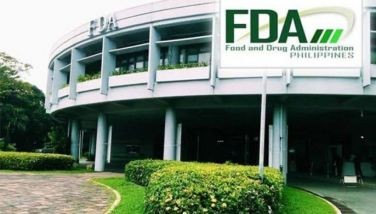Providing a head start

The yellow rain fall warning issued by PAGASA for Metro Manila and other areas due to Typhoon Henry as of this writing brings unavoidably, fears of massive flooding.
For some areas such as Caloocan, Malabon, Navotas and Valenzuela (Camanava), floods have become part of their residents’ lives. These four cities are situated in the estuary of several river deltas and have become prone to frequent flooding, especially during high tides, heavy rains, and when rivers and dams overflow. They are also commonly affected by interconnected rivers, one of which is the Tullahan River.
In recent years, floods have worsened, reaching as much as several feet deep, affecting families in communities along or near the riverbanks. The river is also said to have become narrower and shallower over the years and its capacity to hold water has increased and with intense rains, the riverbanks flood, reaching low-lying and densely populated areas.
In March 2019, San Miguel Corp. signed a landmark MOA with the DENR to implement a comprehensive dredging and cleanup of the 59.42-km Tullahan River system which starts from the La Mesa Reservoir and traverses the cities of Valenzuela and Malabon before reaching the mouth of Manila Bay through Navotas.
After two and a half years, the massive cleanup initiative has been completed, ridding the Tullahan river of over 1.12 million tons of solid waste that had been clogging the river for the longest time.
SMC spent P1 billion of its own money for the Tullahan River clean up and another P2 billion for Pasig River, both heavily polluted and neglected rivers.
SMC’s Tullahan project, together with government’s undertaking to put up pumping stations and fortify river walls to protect communities near the river, have succeeded in mitigating severe flooding in Camanava.
Just a year after the project started, communities reported lesser incidences of severe flooding in their areas, as the Tullahan River was able to channel more flood water away from streets and into Manila Bay.
By extracting wastes, SMC effectively deepened the river, and also widened some portions where silt had built up through the years. As a result, areas of the river that effectively became bottlenecks were freed up, increasing its carrying capacity, and minimizing flooding in flood-prone areas.
With its accomplishment at the Tullahan River, there is now even more heightened anticipation as to what it can achieve for the Pasig River, which it has also been cleaning up since last year. To date, SMC has removed around 510,760 metric tons of silt and waste from the river.
Pasig and Tullahan are among the world’s top 10 largest plastic-emitting rivers, responsible for the world’s ocean plastics, according to a 2021 research by ourworldindata.org.
They are also the rivers where Metro Manila’s untreated sewage usually end up. Incidentally, also on that list are rivers belonging to the Marilao-Meycauayan-Obando River System (MMORS), which SMC is expected to clean-up next as part of its ongoing advocacy.
But as with any river cleanup effort, wins can’t last very long even with the best intentions, if there is no sustained, consolidated effort from all stakeholders. Solid waste management also needs to be addressed by long-lasting solutions. Without this, the Tullahan river can go back to its old, pitiful state.
This is however just the start. If we want to bring back these rivers to a state that is able support healthy marine life, and to make them a source of clean water, all stakeholders must show commitment, action, and behavioral change.
Reducing carbon footprint
One company that is leading the business process outsourcing (BPO) sector’s efforts in helping the country attain its commitments under the Paris Agreement to reduce carbon footprint is TDCX Philippines.
Last April, the British Standards Institution (BSI) awarded TDCX with a satisfactory opinion statement, evaluating that TDCX’s carbon footprint report meets the ISO 14064-1:2018 criteria for greenhouse gas management system documentation.
According to TDCX Philippines vice president for business strategy Eliza Acuna, businesses play an important role in promoting and accelerating sustainability and given the far-reaching impact of climate change, they have made it a priority to reduce carbon footprint across TDCX’ operations globally.
“By contributing to global sustainability targets, we are helping ourselves. We have all experienced volatile energy prices in the past year. To minimize such volatility, we must all play a part in reducing the effects of climate change. It also ensures that we remain competitive in the long run. As governments and businesses incorporate sustainability factors into their requirements, companies that do not meet these criteria may find themselves losing business opportunities as a result. It also helps in our talent strategy. Employees are becoming more conscious about their impact on the environment and want their employer to embrace such values as well,” she said.
Acuna explained that to reduce carbon emissions in its operations, TDCX enabled a hybrid work environment to minimize employee commuting, used energy efficient options and reduced water use and waste production in its offices, invested in renewable energy, and has been educating its employees on environmentally friendly practices and rewarding their efforts.
In weaving sustainability into their operations, she reminded companies that even small efforts such as resource management in offices can be a way to start, adding that it is important to get company leadership onboard to ensure that resources are available to support sustainability objectives.
She said that TDCX is committed to ensuring that its carbon footprint is kept at a minimal and to finding more ways to reduce it further.
“Today, we are proud to have a robust carbon footprint management plan in place to keep us on track. In order to be truly net zero, this needs to extend to all businesses and individuals involved in their operations with TDCX. All these stakeholders must also have their own renewable or net zero goals,” she emphasized.
Acuna added that one way that the government can encourage the BPO sector to become more environmentally friendly is through the establishment of “green” economic zones. This, she said, will lead to developers having a greener push, thus enabling BPOs to improve the sustainability of their operations.
For comments, e-mail at [email protected].
- Latest
- Trending


























